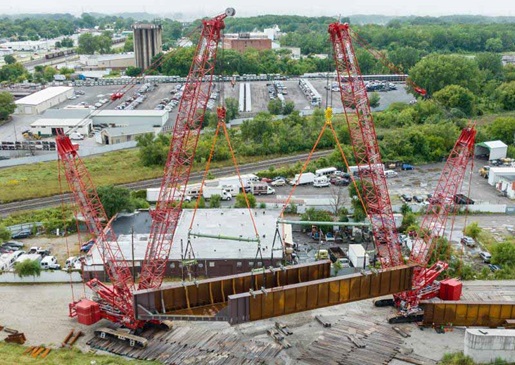
Site access can be one of the most underestimated factors in planning a heavy lift, yet it has the power to disrupt everything from equipment arrival to crane assembly and final execution.
There are a variety of factors that can derail a project that range from rampant rain to logistical logjams. If you’re preparing for a heavy lift, here are key site access tips to keep your project on schedule and your team one step ahead.
Weather: Prepare for the Unpredictable
Inclement weather can pose problems for projects in general – and it can be especially challenging for heavy equipment. Rain, snow, strong winds, and other elements can make roads impassable, soften the ground, and create hazardous conditions for lifting.
What to address:
- Ground conditions: Muddy, saturated ground can stall loaded trailers or prevent cranes from being set up. Consider adding gravel, planks, or ground mats for added stability.
- Wind conditions: Some modern cranes, such as ones made by Liebherr, feature onboard tech that helps operators make real-time adjustments based on wind conditions, but it's still imperative to have a designated member of your team on weather alert.
- Stuck equipment: Always have a contingency plan or even a team on standby for recovering or replacing a loaded trailer that might get stuck during transport or on-site.
Transportation and Permits: Plan Ahead for Logistical Challenges
Your lift doesn’t begin when the crane arrives – it starts when equipment leaves the yard. There are several potential pitfalls associated with transporting cranes, especially when some equipment can require dozens of trucks to reach their destination. Time spent planning for this stage can save you some major headaches when it’s time for delivery.
What to address:
- Route planning: Evaluate every road, bridge, and corner your equipment will travel to ensure they won’t become an issue. A single low-clearance bridge or weight-restricted road can derail your entire plan.
- Permits: Apply for required travel and access permits as soon as routes are mapped. Some permits require coordination with local governments, and that process can take a long time for approval.
- Situational restrictions: City jobs often involve additional permissions, like shutting down streets or coordinating with multiple departments. Determine which types of restrictions there are in the vicinity of your jobsite. For example, needing FAA approval for height clearance at or near an airport.
Loading, Staging, and Assembly: Use Space Wisely
Loading, staging, and assembling takes up a lot of space, and a lack of planning can lead to logistical bottlenecks and delays. For example, a lattice boom crawler can require dozens or even 100 trucks to transport all of the necessary components. It will need a lay down area to assemble the lattice boom, and possibly a new area to disassemble after the job is complete.
What to address:
- Laydown planning: Map out space for staging, building, and storing crane components. Don’t forget about teardown needs too, as you’ll need space for disassembly.
- Multiple areas: Some jobs require more than one laydown area, especially on industrial sites with ongoing operations. Keep access routes open for delivery trucks and ensure each area is stable.
- Efficiency matters: It’s not just about space, it’s about proximity. Long travel distances between staging and lifting zones can cost valuable time, so plan out laydown spaces to make it easier for operators to maneuver their cranes as needed.
Equipment Selection: Let the Site Guide the Specs
While you may have certain crane preferences, your job site may dictate which crane you use. Different environmental factors can make all-terrain cranes, truck cranes, or some other crane a better fit, so make sure to weigh all your needs and make sure your equipment is tailored to your specifications and job site.
What to address:
- Space constraints: Consider the overhead restrictions, potential obstacles, and other factors that will impact working areas and laydown spaces. Tighter environments will require smaller, more mobile cranes, while options like truck cranes can allow for quick entry without the need for assembly.
- Terrain: Soft ground and other uneven terrain may require equipment with off-road capabilities that can allow for easier site access, especially with uncertain weather.
- Load requirements: Evaluate your maximum load requirements so that you can decide which crane can meet performance specifications and quickly and easily access your site.
Plan for Site Access, Because Your Project Depends on It
The crane might be the star of the show, but the whole production stalls if it can’t get on stage. By thoroughly addressing site access, you can limit notable delays and create a more efficient, effective process for your projects.
At ALL Crane, we’ve supported thousands of lifts across North America, and we’ve seen firsthand how weather, permits, logistics, and equipment decisions can affect a job site. Contact us today if you need help investing in the right cranes, navigating logistical challenges, and creating a lift plan catered to your project.
